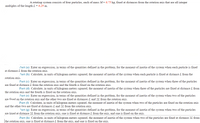
Elements Of Electromagnetics
7th Edition
ISBN: 9780190698614
Author: Sadiku, Matthew N. O.
Publisher: Oxford University Press
expand_more
expand_more
format_list_bulleted
Question
PLEASE ANSWER ALL PARTS AND CIRCLE ANSWERS! THANK YOU. WILL GIVE GOOD RATING.

Transcribed Image Text:A rotating system consists of four particles, each of mass M= 0.75 kg, fixed at distances from the rotation axis that are all integer
multiples of the length L = 0.29 m.
Part (a) Enter an expression, in terms of the quantities defined in the problem, for the moment of inertia of the system when each particle is fixed
at distance L from the rotation axis.
Part (b) Calculate, in units of kilogram meters squared, the moment of inertia of the system when each particle is fixed at distance L from the
rotation axis.
Part (c) Enter an expression, in terms of the quantities defined in the problem, for the moment of inertia of the system when three of the particles
are fixed at distance L from the rotation axis and the fourth is fixed on the rotation axis.
Part (d) Calculate, in units of kilogram meters squared, the moment of inertia of the system when three of the particles are fixed at distance L from
the rotation axis and the fourth is fixed on the rotation axis.
Part (e) Enter an expression, in terms of the quantities defined in the problem, for the moment of inertia of the system when two of the particles
are fixed on the rotation axis and the other two are fixed at distances L and 2L from the rotation axis.
Part (f) Calculate, in units of kilogram meters squared, the moment of inertia of the system when two of the particles are fixed on the rotation axis
and the other two are fixed at distances L and 2L from the rotation axis.
'art (g) Enter an expression, in terms of the quantities defined in the problem, for the moment of inertia of the system when two of the particles
are tixed at distance 2L from the rotation axis, one is fixed at distance L from the axis, and one is fixed on the axis.
Part (h) Calculate, in units of kilogram meters squared, the moment of inertia of the system when two of the particles are fixed at distance 2L from
the rotation axis, one is fixed at distance L from the axis, and one is fixed on the axis.
Expert Solution
This question has been solved!
Explore an expertly crafted, step-by-step solution for a thorough understanding of key concepts.
This is a popular solution
Trending nowThis is a popular solution!
Step by stepSolved in 2 steps with 4 images

Knowledge Booster
Learn more about
Need a deep-dive on the concept behind this application? Look no further. Learn more about this topic, mechanical-engineering and related others by exploring similar questions and additional content below.Similar questions
- what is the xbar distance (from left edge of part)?arrow_forwardI need help answering this quick review pertaining to the print provided.arrow_forwardTwo lengths of steel are aut off firm a 187.573" length for a job. Piece1 is a5.729" long and piece 2 is 58.137" long. what is the to tal length of pipe used for the job?arrow_forward
arrow_back_ios
arrow_forward_ios
Recommended textbooks for you
 Elements Of ElectromagneticsMechanical EngineeringISBN:9780190698614Author:Sadiku, Matthew N. O.Publisher:Oxford University Press
Elements Of ElectromagneticsMechanical EngineeringISBN:9780190698614Author:Sadiku, Matthew N. O.Publisher:Oxford University Press Mechanics of Materials (10th Edition)Mechanical EngineeringISBN:9780134319650Author:Russell C. HibbelerPublisher:PEARSON
Mechanics of Materials (10th Edition)Mechanical EngineeringISBN:9780134319650Author:Russell C. HibbelerPublisher:PEARSON Thermodynamics: An Engineering ApproachMechanical EngineeringISBN:9781259822674Author:Yunus A. Cengel Dr., Michael A. BolesPublisher:McGraw-Hill Education
Thermodynamics: An Engineering ApproachMechanical EngineeringISBN:9781259822674Author:Yunus A. Cengel Dr., Michael A. BolesPublisher:McGraw-Hill Education Control Systems EngineeringMechanical EngineeringISBN:9781118170519Author:Norman S. NisePublisher:WILEY
Control Systems EngineeringMechanical EngineeringISBN:9781118170519Author:Norman S. NisePublisher:WILEY Mechanics of Materials (MindTap Course List)Mechanical EngineeringISBN:9781337093347Author:Barry J. Goodno, James M. GerePublisher:Cengage Learning
Mechanics of Materials (MindTap Course List)Mechanical EngineeringISBN:9781337093347Author:Barry J. Goodno, James M. GerePublisher:Cengage Learning Engineering Mechanics: StaticsMechanical EngineeringISBN:9781118807330Author:James L. Meriam, L. G. Kraige, J. N. BoltonPublisher:WILEY
Engineering Mechanics: StaticsMechanical EngineeringISBN:9781118807330Author:James L. Meriam, L. G. Kraige, J. N. BoltonPublisher:WILEY

Elements Of Electromagnetics
Mechanical Engineering
ISBN:9780190698614
Author:Sadiku, Matthew N. O.
Publisher:Oxford University Press

Mechanics of Materials (10th Edition)
Mechanical Engineering
ISBN:9780134319650
Author:Russell C. Hibbeler
Publisher:PEARSON

Thermodynamics: An Engineering Approach
Mechanical Engineering
ISBN:9781259822674
Author:Yunus A. Cengel Dr., Michael A. Boles
Publisher:McGraw-Hill Education

Control Systems Engineering
Mechanical Engineering
ISBN:9781118170519
Author:Norman S. Nise
Publisher:WILEY

Mechanics of Materials (MindTap Course List)
Mechanical Engineering
ISBN:9781337093347
Author:Barry J. Goodno, James M. Gere
Publisher:Cengage Learning

Engineering Mechanics: Statics
Mechanical Engineering
ISBN:9781118807330
Author:James L. Meriam, L. G. Kraige, J. N. Bolton
Publisher:WILEY